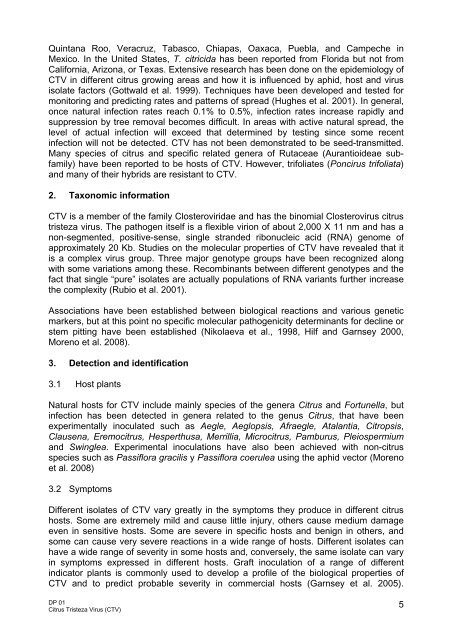NAPPO DIAGNOSTIC PROTOCOLS DP 01 Citrus Tristeza Virus (CTV)
NAPPO DIAGNOSTIC PROTOCOLS DP 01 Citrus Tristeza Virus (CTV)
NAPPO DIAGNOSTIC PROTOCOLS DP 01 Citrus Tristeza Virus (CTV)
- No tags were found...
Create successful ePaper yourself
Turn your PDF publications into a flip-book with our unique Google optimized e-Paper software.
Quintana Roo, Veracruz, Tabasco, Chiapas, Oaxaca, Puebla, and Campeche inMexico. In the United States, T. citricida has been reported from Florida but not fromCalifornia, Arizona, or Texas. Extensive research has been done on the epidemiology of<strong>CTV</strong> in different citrus growing areas and how it is influenced by aphid, host and virusisolate factors (Gottwald et al. 1999). Techniques have been developed and tested formonitoring and predicting rates and patterns of spread (Hughes et al. 20<strong>01</strong>). In general,once natural infection rates reach 0.1% to 0.5%, infection rates increase rapidly andsuppression by tree removal becomes difficult. In areas with active natural spread, thelevel of actual infection will exceed that determined by testing since some recentinfection will not be detected. <strong>CTV</strong> has not been demonstrated to be seed-transmitted.Many species of citrus and specific related genera of Rutaceae (Aurantioideae subfamily)have been reported to be hosts of <strong>CTV</strong>. However, trifoliates (Poncirus trifoliata)and many of their hybrids are resistant to <strong>CTV</strong>.2. Taxonomic information<strong>CTV</strong> is a member of the family Closteroviridae and has the binomial Closterovirus citrustristeza virus. The pathogen itself is a flexible virion of about 2,000 X 11 nm and has anon-segmented, positive-sense, single stranded ribonucleic acid (RNA) genome ofapproximately 20 Kb. Studies on the molecular properties of <strong>CTV</strong> have revealed that itis a complex virus group. Three major genotype groups have been recognized alongwith some variations among these. Recombinants between different genotypes and thefact that single “pure” isolates are actually populations of RNA variants further increasethe complexity (Rubio et al. 20<strong>01</strong>).Associations have been established between biological reactions and various geneticmarkers, but at this point no specific molecular pathogenicity determinants for decline orstem pitting have been established (Nikolaeva et al., 1998, Hilf and Garnsey 2000,Moreno et al. 2008).3. Detection and identification3.1 Host plantsNatural hosts for <strong>CTV</strong> include mainly species of the genera <strong>Citrus</strong> and Fortunella, butinfection has been detected in genera related to the genus <strong>Citrus</strong>, that have beenexperimentally inoculated such as Aegle, Aeglopsis, Afraegle, Atalantia, Citropsis,Clausena, Eremocitrus, Hesperthusa, Merrillia, Microcitrus, Pamburus, Pleiospermiumand Swinglea. Experimental inoculations have also been achieved with non-citrusspecies such as Passiflora gracilis y Passiflora coerulea using the aphid vector (Morenoet al. 2008)3.2 SymptomsDifferent isolates of <strong>CTV</strong> vary greatly in the symptoms they produce in different citrushosts. Some are extremely mild and cause little injury, others cause medium damageeven in sensitive hosts. Some are severe in specific hosts and benign in others, andsome can cause very severe reactions in a wide range of hosts. Different isolates canhave a wide range of severity in some hosts and, conversely, the same isolate can varyin symptoms expressed in different hosts. Graft inoculation of a range of differentindicator plants is commonly used to develop a profile of the biological properties of<strong>CTV</strong> and to predict probable severity in commercial hosts (Garnsey et al. 2005).<strong>DP</strong> <strong>01</strong><strong>Citrus</strong> <strong>Tristeza</strong> <strong>Virus</strong> (<strong>CTV</strong>)5













